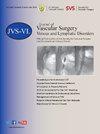Evaluation of hemodynamic characteristics of iliac vein in chronic venous disease and iliac vein compression syndrome patients using magnetic resonance image: A prospective study
IF 2.8
2区 医学
Q2 PERIPHERAL VASCULAR DISEASE
Journal of vascular surgery. Venous and lymphatic disorders
Pub Date : 2025-04-08
DOI:10.1016/j.jvsv.2025.102247
引用次数: 0
Abstract
Objective
The purpose of this study was to explore the characteristics of hemodynamic parameters of iliac vein of patients with chronic venous disease (CVD) using two-dimensional (2D)-phase contrasted (PC) and four-dimensional (4D)-Flow magnetic resonance imaging (MRI) and to test the diagnostic and grading efficiency of 2D-PC and 4D-Flow MRI in CVD and iliac vein compression syndrome (IVCS).
Methods
Consecutive patients with CVD diagnosed in the outpatient department from 2023 to 2024 were enrolled in this study. Demographic data and medical records of the patients were also collected. The CEAP classification, Villalta score, and Venous Clinical Severity Score (VCSS) were used to evaluate the severity of lower limb symptoms. After computational tomography venography (CTV) scans to verify iliac vein compression, every patient underwent 2D-PC and 4D-Flow MRI scanning. Circle CVI42 software was used to perform data post processing. The inferior vena cava (IVC), common iliac vein (CIV), and common femoral vein (CFV) were chosen to acquire hemodynamic parameters by MRI. The hemodynamic parameter included flow rate (FR) per cardiac cycle, FR per minute, peak flow velocity (FV) and minimum FV measured by 2D-PC MRI and FR per cardiac cycle, peak FV and pressure gradient measured by 4D-Flow MRI. We analyzed the consistency of hemodynamic parameters between 2D-PC and 4D-Flow MRI, the differences in hemodynamic parameters between symptomatic and asymptomatic limbs and limbs with and without iliac vein compression, and the correlation between parameters and severity of symptoms.
Results
A total of 34 individuals, including three healthy volunteers, 15 patients with CVD and iliac vein compression, and 16 patients with CVD without IVCS, were enrolled in this study. Hemodynamic parameters measured by 2D-PC and 4D-Flow MRI complied with the flow rate conservation and maintained consistency (P < .01). There was a statistically significant difference in the FR of the CIV and FR difference between the CIV and CFV measured by 2D-PC and 4D-Flow MRI between symptomatic and asymptomatic limbs (2D-PC MRI: FR of CIV: 6.0 ± 3.1 vs 8.5 ± 5.1; P = .01; FR difference: 1.6 ± 2.1 vs 3.6 ± 4.3; P = .01) (4D-Flow MRI: FR of CIV: 6.9 ± 2.8 vs 8.7 ± 4.2; P = .04; FR difference: 3.0 ± 2.8 vs 4.8 ± 3.5; P = .05), and limbs with and without iliac vein compression (2D-PC MRI: FR of CIV: 5.3 ± 3.0 vs 7.6 ± 4.4; P = .03; FR difference: 1.3 ± 2.7 vs 2.8 ± 3.4; P = .04) (4D-Flow MRI FR of CIV: 6.1 ± 2.6 vs 8.2 ± 3.7; P < .01; FR difference: 2.1 ± 3.7 vs 4.6 ± 3.1; P = .04). The FR of the CIV and the FR difference between the CIV and CFV were negatively correlated with symptom severity in all affected limbs (2D-PC MRI: FR of CIV: P < .01; r = −0.3; FR difference: P = .03; r = −0.3). There was a potential negative correlation between the FR of the CIV in limbs with iliac vein compression and the severity of symptoms (2D-PC MRI: FR of CIV: P = .07; r = −0.4).
Conclusions
In conclusion, hemodynamic parameters provided by 2D-PC and 4D-Flow MRI possess the potential clinical value of evaluating CVD and iliac vein compression.
磁共振成像评价慢性静脉疾病和髂静脉压迫综合征患者髂静脉血流动力学特征:一项前瞻性研究。
目的:探讨二维(2D)相对比(PC)和四维(4D)血流磁共振成像(MRI)对慢性静脉疾病(CVD)患者髂静脉血流动力学参数的特点,并探讨二维(2D)相对比(PC)和4D-Flow MRI对CVD和髂静脉压迫综合征(IVCS)的诊断和分级效率。方法:研究对象为2023 - 2024年门诊诊断为心血管疾病的连续患者。还收集了患者的人口统计数据和医疗记录。采用CEAP分类、Villalta评分和静脉临床严重程度评分(VCSS)评估下肢症状的严重程度。在计算机断层血管造影(CTV)扫描以验证髂静脉受压后,每位患者进行2D-PC和4D-Flow MRI扫描。采用Circle CVI42软件进行数据后处理。选取下腔静脉(IVC)、髂总静脉(CIV)和股总静脉(CFV)进行MRI血流动力学参数采集。血流动力学参数包括2D-PC MRI测量的每心循环流速(FR)、每分钟流速(FR)、峰值流速(FV)和最小流速(FV),以及4D-Flow MRI测量的每心循环流速、峰值流速和压力梯度。分析2D-PC与4D-Flow MRI血流动力学参数的一致性,有症状与无症状肢体、有无髂静脉压迫肢体血流动力学参数的差异,以及参数与症状严重程度的相关性。结果:本研究共纳入34人,包括3名健康志愿者,15名CVD合并髂静脉压迫患者,16名CVD合并非IVCS患者。2D-PC和4D-Flow MRI测量的血流动力学参数符合血流速率守恒并保持一致性(P < 0.01)。有症状和无症状肢体间2D-PC和4D-Flow MRI测量的CIV和CFV的FR差异有统计学意义(2D-PC MRI: CIV的FR: 6.0±3.1 vs 8.5±5.1;P = 0.01;FR差异:1.6±2.1 vs 3.6±4.3;P = 0.01) (4D-Flow MRI: CIV的FR: 6.9±2.8 vs 8.7±4.2;P = .04;FR差异:3.0±2.8 vs 4.8±3.5;P = 0.05),以及有无髂静脉压迫的四肢(2D-PC MRI: CIV的FR: 5.3±3.0 vs 7.6±4.4;P = .03;FR差异:1.3±2.7 vs 2.8±3.4;(CIV的4D-Flow MRI FR: 6.1±2.6 vs 8.2±3.7;P < 0.01;FR差异:2.1±3.7 vs 4.6±3.1;P = .04)。CIV的FR和CIV与CFV之间的FR差异与所有患肢的症状严重程度呈负相关(2D-PC MRI: CIV的FR: P < 0.01;r = -0.3;FR差异:P = .03;r = -0.3)。伴有髂静脉压迫的肢体CIV的FR与症状严重程度之间存在潜在的负相关(2D-PC MRI: CIV的FR: P = 0.07;r = -0.4)。结论:2D-PC和4D-Flow MRI提供的血流动力学参数在评估CVD和髂静脉压迫方面具有潜在的临床价值。
本文章由计算机程序翻译,如有差异,请以英文原文为准。
求助全文
约1分钟内获得全文
求助全文
来源期刊

Journal of vascular surgery. Venous and lymphatic disorders
SURGERYPERIPHERAL VASCULAR DISEASE&n-PERIPHERAL VASCULAR DISEASE
CiteScore
6.30
自引率
18.80%
发文量
328
审稿时长
71 days
期刊介绍:
Journal of Vascular Surgery: Venous and Lymphatic Disorders is one of a series of specialist journals launched by the Journal of Vascular Surgery. It aims to be the premier international Journal of medical, endovascular and surgical management of venous and lymphatic disorders. It publishes high quality clinical, research, case reports, techniques, and practice manuscripts related to all aspects of venous and lymphatic disorders, including malformations and wound care, with an emphasis on the practicing clinician. The journal seeks to provide novel and timely information to vascular surgeons, interventionalists, phlebologists, wound care specialists, and allied health professionals who treat patients presenting with vascular and lymphatic disorders. As the official publication of The Society for Vascular Surgery and the American Venous Forum, the Journal will publish, after peer review, selected papers presented at the annual meeting of these organizations and affiliated vascular societies, as well as original articles from members and non-members.
 求助内容:
求助内容: 应助结果提醒方式:
应助结果提醒方式:


